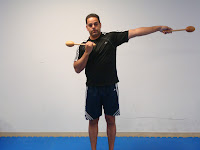I've had the pleasure of working with fighters from different
disciplines including boxing, wrestling, mixed martial arts, Brazilian jiu
jitsu and Muay Thai and one thing I've found is none of them were "strong
enough".
I hear so often that strength training isn't important and that fighters
should just focus on technique. This is bad.
A fighter, just like any other athlete, needs to be concerned with
strength, power, speed, agility, mobility, flexibility and specific skill work.
Of course the levels of each depend on the requirements of the sport and what
the athlete's current level of preparation is.
What a lot of fighters don't realize is that there are essentially two
types of physical preparation for their sport - general physical preparation
(GPP)-which constitutes strength training, power training, speed training,
agility training, flexibility training, etc-and specific physical preparation
(SPP)-which is essentially fight training, technique work, sparring, etc.
 |
| Kettlebell training is great supplementary work for fighters, just make sure to do it AFTER you've done your squats, presses and deadlifts! |
When you say strength training, people automatically assume you mean a
super fat, highly immobile powerlifter. No. That's not the case. I say that if
you have two fighters squaring off, both of equal skill levels, and one of them
spends a bit of time getting stronger while the other only focuses on technique
development, I'm putting my money on the guy who's lifted some weight.
I remember a couple years ago talking to my friend Brian Gausman during one of our training sessions about fighters and strength training. Brian is a pretty damn strong guy himself and knows a thing or twelve about MMA and fight preparation so this comment from him was absolute gold-he said, "If strength isn't important to fighters then why the hell are so many of them getting popped for steroids and performance enhancers?" Logic at its finest. That's Brian for you.
It's also important to note that increased strength has a positive impact on speed. Doubt that statement? I remember reading an old squat training article by the great Louie Simmons of Westside Barbell in which he made the comment that sprinter Ben Johnson had made a 620 lb squat at under 200 lbs bodyweight. I'm sure if you checked the training logs of many other good sprinters you'd see some impressive squat numbers.
I remember a couple years ago talking to my friend Brian Gausman during one of our training sessions about fighters and strength training. Brian is a pretty damn strong guy himself and knows a thing or twelve about MMA and fight preparation so this comment from him was absolute gold-he said, "If strength isn't important to fighters then why the hell are so many of them getting popped for steroids and performance enhancers?" Logic at its finest. That's Brian for you.
It's also important to note that increased strength has a positive impact on speed. Doubt that statement? I remember reading an old squat training article by the great Louie Simmons of Westside Barbell in which he made the comment that sprinter Ben Johnson had made a 620 lb squat at under 200 lbs bodyweight. I'm sure if you checked the training logs of many other good sprinters you'd see some impressive squat numbers.
Think of strength training as one tool in the tool box - don't make it
the ONLY tool, but why wouldn't you spend some time developing that physical
quality, just as you would spend developing the cardiovascular system, specific
skills, etc.?
The best cure for this is to lift barbells. Heavy ones.
Please understand I am not suggesting fighters start killing themselves
under 1-rep max loads like a powerlifter-but I am suggesting that adding more
weight to basic movements like squats, deadlifts, bench presses, barbell rows,
etc. is a great thing for all fighters to do.
 |
| Granted, most fighters don't need to be as strong as Derrick - but adding a plate or two in an awesome lift like the deadlift would be time well spent for ANY fighter! |
Also - keep in mind, strength training is only one spoke in the physical
preparation wheel, there is mobility / flexibility, aerobic and anaerobic
conditioning, speed, power, agility and specific physical development.
Thus a fighter's time spent lifting weights should accomplish his or her
goals with the fewest number of exercises and not interfere with the other
physical qualities that need attention.
 |
BJJ purple belt Jason Gaskill doing a little technique work with kettlebells. Heavy kettlebell clean and presses can make a great tool in a fighter's strength & conditioning tool box.
|
That's all. Two days a week. Why so little? Because he had four days of
BJJ training, 2-3 days of low intensity cardio (cardiac development work) and
1-2 days of anaerobic work (various types of sprints).
Results? He dropped about 40 lbs, got a lot stronger, and into the best
shape of his life. He also had the best showing out of everyone from his BJJ
team that participated at Pan-Ams.
Keep in mind that you don't need to go in the gym and spend hours and
hours doing every exercise or machine under the sun. A basic program of squats,
deadlifts, bench presses, chins, rows, overhead press, some jumps and heavy ab
work will do wonders for most fighters.
How strong do you need to be? Who cares. Just strive to add more weight
to the lifts-whether it's for 1 rep, 3 reps, 5 reps-I don't care. More weight
and / or more reps mean you've gotten stronger. Leave the fancy formulas to the
Exercise Physiology geeks. Just use good technique and common sense and you
should be fine.
There is no reason to turn your weight room time into another
conditioning session - you should be getting plenty of that from your road work
and your sparring and skill training - save the weight room time for what it is
intended for - to get stronger!
Stay Strong and Healthy!
-Scott











